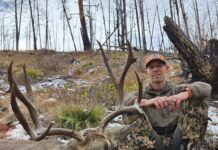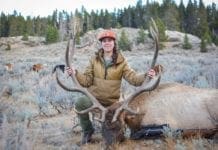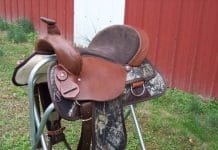Hunting with Horses
by Cindy Wamsley
All hunting trips require a great deal of preparation. Add horses to the mix and you’ve got another element to prepare for. It is important to provide all the basic elements of survival for horses. They need food, water, shelter and the necessary equipment to help them do the job they are asked to perform.

When planning a supply list for a hunt, a great place to start is by categorizing the basic needs. The type of hunt taking place will determine the type of supplies needed. For instance, whether or not you will hunt from a base camp each day or stay overnight on the mountain will determine much of the supply list. For horses I categorize five main areas; 1) water and food 2) shelter 3) tack 4) First Aid and 5) transportation.
Water and Food
Whether you need to pack water and food or find it where you are will depend on the location of the hunt and availability of food and water sources. Study the maps and mark the water sources; creeks, springs, water holes, rivers, lakes, etc. Then do some preseason scouting with your horse and check to make sure those sources listed on the map are valid sources for water. Remember the seasons, water in the spring may not be there in the fall, so you will want to make sure there is a good source for drinking. Also look for grazing areas to use. The length of the trip will determine how much feed you need to bring. Don’t forget that all feed packed into the national forest must be certified weed free. A good rule of thumb for the amount of feed per day per horse is to figure 1-2% of the body weight depending on the activity level. For example, a 1000 pound horse fed 1% of its body weight = 10 pounds feed per day and 2% = 20 pounds feed per day. If you feed grain or an another supplement besides hay, make sure your horses are accustomed to that feed before leave for the hunt. The actual daily amount of water that most horses need to consume (at a minimum) to maintain body functions and remain properly hydrated is from a half gallon to a gallon per 100 pounds of body weight. This works out to be a minimum of 5 to 10 gallons for a 1,000-pound horse that is not presently doing any work and is living in a temperate climate. If you increase the horse’s workload or the environmental temperatures are elevated, then this will increase the demand for water.

Shelter
Horses are better acclimated to the elements than we are. They are good at getting out of the weather and using natural geographic features to find shelter. In the event you are going to be in severe weather or out in the open, pack some supplies to construct a temporary shelter. Also, bring a good horse blanket as a back up if needed.
Tack
This category will vary based on personal preference. Each horse may need some specific items based on individual needs. As an owner, you will know what those items are. Saddle horses as well as pack horses will have tack specific to their work responsibility. Check all cinches, straps, buckles, screws, etc., before you go. Replace or repair cracked or dried out leather. Having a cinch strap break under the added weight when packing out your animal is a disaster you can avoid with thorough preparation. Make your horses job easier for him by having the best equipment you can provide. Tack up your horse before the hunt and let them get used to the equipment, in other words break it in. You wouldn’t want to hike 20 miles with bad boots or an ill fitting pack and neither does your horse.
First Aid
Be prepared to handle any horse emergencies that may arise. Your horse is depending on you for it’s survival. Talk to your veterinarian and have him or her help you put together a first aid kit to pack with you. He or she can also give you some basic first aid instruction so you will be prepared to provide medical care for your horse.
Transportation
I categorize transportation into two categories, one for hoof care and the other to get the horse to the trailhead. It is a good idea to talk with your farrier and have him or her show you how to replace a thrown shoe. Bring boots that will replace shoes as an alternative. Transporting your horse to and from your hunting area will usually require trailering. As with any type of trailering you’ll want to make sure the trailer and truck are in good working order. Check the tire pressure, hitches, jacks, lights, doors, windows, dividers, brakes, spare tire, etc. Bring automotive tools just in case you have a break down and need to repair something. Depending on the length of the trip you may need to consider items like feed bags, water and buckets if you need to feed along the way. Do not forget your equine paperwork. This usually requires a brand inspection, health certificate and negative Coggins test. Be sure to check the specific requirements based on the state or states you are hunting.
Here’s a general example of what your checklist might include.

WATER & FEED
Timothy/Alfalfa Cubes
20 lbs. Per horse per day
Grain or Supplement
(Amount based on what type of grain or supplement you prefer to feed)
10 Gallons Water Per horse per day
Minimum
SHELTER
Horse blanket
Ax
Wyoming Saw
Tarp
Rope
Shovel
TACK
Halter
Lead rope
Bridle w/reins
Breast collar
Saddle
Saddle pad
Crupper strap (for steep country)
Scabbard
Saddle bags
Pack saddle
Pack saddle pad
Panniers or bags
Rope
Scale (to even the load)
Buckets
Hay bag
Grooming brushes
Curry comb
Horse First Aid
Thermometer
Stethoscope
Sharp scissors
Latex gloves
Sterile bangages – such as tefla pads. Nonstick pads.
Leg bandages
Vet wrap
Diapers – for excessive wound bleeding
Adhesive tape
Antibacterial soap
Antibacterial ointment
Gauze
Epsom Salt – used for soaking feet and drawing out abcesses.
Witch Hazel – used for itchy skin.
Phenylbutazone (bute) for pain relief.
Clean bucket
Clean sponge
Clean rags
Hypodermic syringe (without needle) for cleaning wounds
Empty spray bottle for cleaning wounds
Banamine – for colic treatment
Penicillin
Antiseptic/disinfectant such as betadine or peroxide
Nitrofurazone ointment – for minor wounds and burns.
Vetericyn
30 cc syringe
10 cc syringe
18 gauge 1 1/2 inch needles
Fly spray or wipes
Electrolytes
KY Jelly
Duct Tape
Headlamp
Wire cutters
Leatherman
Twitch
TRANSPORTATION
Tree saver straps
Hobbles
Bell and strap
Picket rope & stake
Truck
Horse Trailer
Horse Paperwork
Shoe Kit
Rasp
Hammer
Hoof knife
Hoof pick
Pullers
Clinchers
Horse shoe nails
(2) Horse shoes of each size that your horse wears
This checklist is meant as a framework to get you started. Experience in the field will help you fine tune your checklist. Hunting with horses can be a fun and enjoyable experience. The more preparation you put into yourself and your horses will pay big dividends on the hunt.


















